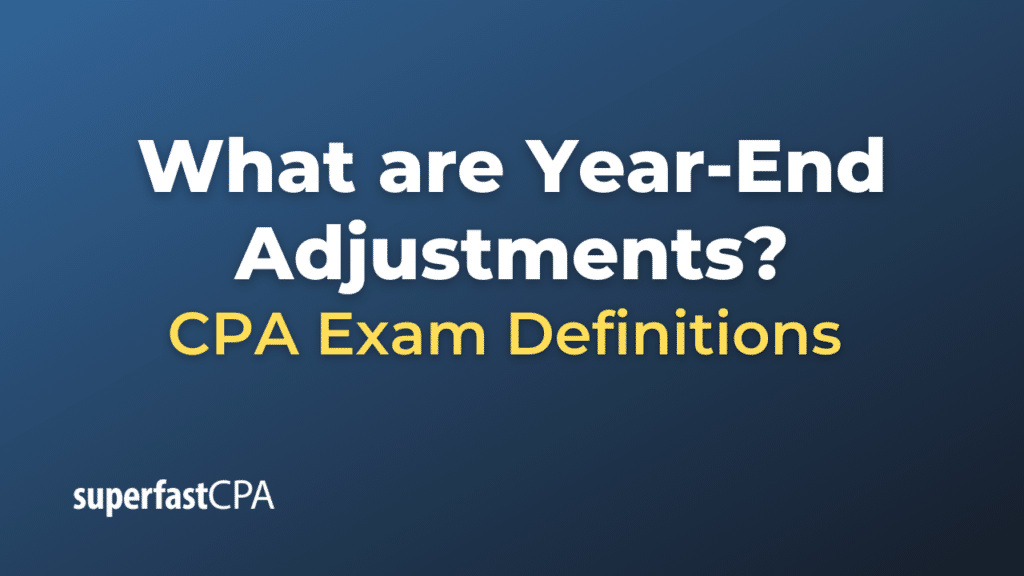Year-End Adjustments
Year-end adjustments are accounting entries made to various general ledger accounts at the end of the fiscal year to bring them into compliance with the accrual basis of accounting. These adjustments are necessary to provide a complete and accurate view of a company’s financial position and performance for the year. The adjustments help to ensure that revenue and expenses are recorded in the period they are earned or incurred, rather than when the money is received or paid.
Here are some common types of year-end adjustments:
1. Accruals
Expense Accruals: Expenses that have been incurred but not yet paid are recorded as accruals. For example, if a company received utility services in December but will not pay the bill until January, an accrual for the expense and a corresponding liability would be recorded.
Revenue Accruals: Revenues that have been earned but not yet received are also recorded as accruals. For instance, if a company performed services in December but will not collect payment until January, an accrual for the revenue and a corresponding accounts receivable would be recorded.
2. Prepayments
Prepaid Expenses: Expenses that are paid in advance, like insurance premiums or rent, need to be adjusted to allocate the portion that pertains to the next accounting period. The prepayment is initially recorded as an asset and then gradually expensed over the period it covers.
Unearned Revenue: Money received in advance for services that have not yet been rendered should be recorded as a liability (unearned revenue) until the service is performed.
3. Depreciation and Amortization
The cost of long-term assets like machinery, buildings, and intangible assets is spread over their useful lives. Year-end adjustments are made to record the depreciation or amortization expense for the year.
4. Bad Debt
An adjustment may be needed to write off accounts receivable that are expected to be uncollectible.
5. Inventory Adjustments
After a physical count of inventory, adjustments might be needed to align the book value of inventory with the actual physical count.
6. Income Tax
Adjustments for income tax expense are made based on the income for the year and the applicable tax rates.
Example of Year-End Adjustments
Let’s consider a different business—a small software development company called “CodeCrafters Inc.” Its fiscal year also ends on December 31st, and the company’s accountant, Emily, is responsible for making the year-end adjustments.
As December 31 approaches, Emily reviews the company’s accounting records and notices several areas that require year-end adjustments.
1. Accrued Salaries
CodeCrafters owes its employees salaries amounting to $5,000 for the last week of December, which won’t be paid until January. Emily needs to account for this salary expense that was incurred but not paid.
Journal Entry:
- Debit Salary Expense $5,000
- Credit Salary Payable $5,000
2. Unearned Revenue
CodeCrafters received a payment of $6,000 in December for a software project that will be delivered in February. Emily records this as unearned revenue, a liability, since the service has not yet been provided.
Journal Entry:
- Debit Cash $6,000
- Credit Unearned Revenue $6,000
3. Office Supplies
CodeCrafters started the year with $500 worth of office supplies and purchased another $1,000 during the year. At the end of the year, there are $200 worth of supplies remaining. Emily adjusts the office supplies expense account accordingly.
Journal Entry:
- Debit Office Supplies Expense $1,300
- Credit Office Supplies $1,300
4. Depreciation
CodeCrafters owns computers and servers worth $12,000, with a useful life of 4 years. That’s a $3,000 depreciation expense for the year.
Journal Entry:
- Debit Depreciation Expense $3,000
- Credit Accumulated Depreciation $3,000
5. Software Licensing Revenue
CodeCrafters sold licenses for one of its software products, generating $4,000 in December. However, the customers won’t pay until January. Emily accrues this as revenue.
Journal Entry:
- Debit Accounts Receivable $4,000
- Credit Software License Revenue $4,000
6. Accrued Interest Expense
CodeCrafters took out a loan and has an interest expense of $200 that won’t be paid until January. Emily accrues the interest expense.
Journal Entry:
- Debit Interest Expense $200
- Credit Interest Payable $200
Result
After making these year-end adjustments, Emily can prepare accurate financial statements for CodeCrafters Inc. These adjustments align the accounting records with the accrual basis of accounting, ensuring that all income and expenses are recorded in the correct accounting period.
By making these year-end adjustments, Emily ensures that the company’s financial statements provide a true and accurate reflection of its financial position and performance, helping stakeholders make informed decisions.













